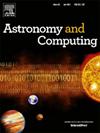AutoKnots:用于样条插值的自适应结分配
IF 1.8
4区 物理与天体物理
Q2 ASTRONOMY & ASTROPHYSICS
引用次数: 0
摘要
在天体物理学和宇宙学分析中,天文数据的质量和数量的增加需要高效和精确的计算工具。插值方法,特别是基于样条的方法,在这种情况下起着关键作用。这项工作介绍了一种新的自适应算法,用于样条插值中的自动节(AutoKnots)分配,旨在满足用户自定义的精度要求。与依赖手动配置结分布的传统方法不同,该技术基于插值误差标准自动确定最佳结数和位置,通常只需要一个参数。该算法通过在插值误差超过所需阈值的区域自适应采样待逼近函数f(x)来逐步改进插值。所有函数的评估都有助于最终的近似,从而确保效率。虽然每个重采样步骤都涉及到重新计算插值表,但这个过程是高度优化的,与计算f(x)的成本相比,计算上可以忽略不计。对于固有的快速函数,插值可能不会提供显著的好处。对不同函数的精度测试证明了算法的有效性,而启发式增强则提高了平面区域的精度。集成到数值宇宙学库(NumCosmo)中,该算法已被广泛使用和测试。NumCosmo包括严格的单元测试,强调其健壮性和可靠性。作为实际应用,我们计算了navarro - frank - white和Hernquist光晕密度剖面的表面质量密度Σ(R)和平均表面质量密度Σ¯(<;R),提供了分析基准。这种自适应算法为计算天体物理学和宇宙学中的插值挑战提供了一种成熟的、用户友好的工具。本文章由计算机程序翻译,如有差异,请以英文原文为准。

AutoKnots: Adaptive knot allocation for spline interpolation
In astrophysical and cosmological analyses, the increasing quality and volume of astronomical data demand efficient and precise computational tools. Interpolation methods, particularly spline-based approaches, play a critical role in this context. This work introduces a novel adaptive algorithm for automatic knots (AutoKnots) allocation in spline interpolation, designed to meet user-defined precision requirements. Unlike traditional methods relying on manually configured knot distributions, the proposed technique automatically determines the optimal number and placement of knots based on interpolation error criteria, often requiring only a single parameter. The algorithm progressively improves interpolation by adaptively sampling the function-to-be-approximated, , in regions where the interpolation error exceeds the desired threshold. All function evaluations contribute to the final approximation, ensuring efficiency. Although each resampling step involves recomputing the interpolation table, this process is highly optimized and computationally negligible compared to the cost of evaluating . For inherently fast functions, interpolation may not offer significant benefits. Precision tests on different functions demonstrate the algorithm’s efficacy, while a heuristic enhancement improves accuracy in flat regions. Integrated into the Numerical Cosmology library (NumCosmo), this algorithm has been extensively used and tested. NumCosmo includes rigorous unit tests that underscore its robustness and reliability. As a practical application, we compute the surface mass density and average surface mass density for Navarro–Frenk–White and Hernquist halo density profiles, offering analytical benchmarks. This adaptive algorithm provides a mature, user-friendly tool for interpolation challenges in computational astrophysics and cosmology.
求助全文
通过发布文献求助,成功后即可免费获取论文全文。
去求助
来源期刊

Astronomy and Computing
ASTRONOMY & ASTROPHYSICSCOMPUTER SCIENCE,-COMPUTER SCIENCE, INTERDISCIPLINARY APPLICATIONS
CiteScore
4.10
自引率
8.00%
发文量
67
期刊介绍:
Astronomy and Computing is a peer-reviewed journal that focuses on the broad area between astronomy, computer science and information technology. The journal aims to publish the work of scientists and (software) engineers in all aspects of astronomical computing, including the collection, analysis, reduction, visualisation, preservation and dissemination of data, and the development of astronomical software and simulations. The journal covers applications for academic computer science techniques to astronomy, as well as novel applications of information technologies within astronomy.
 求助内容:
求助内容: 应助结果提醒方式:
应助结果提醒方式:


